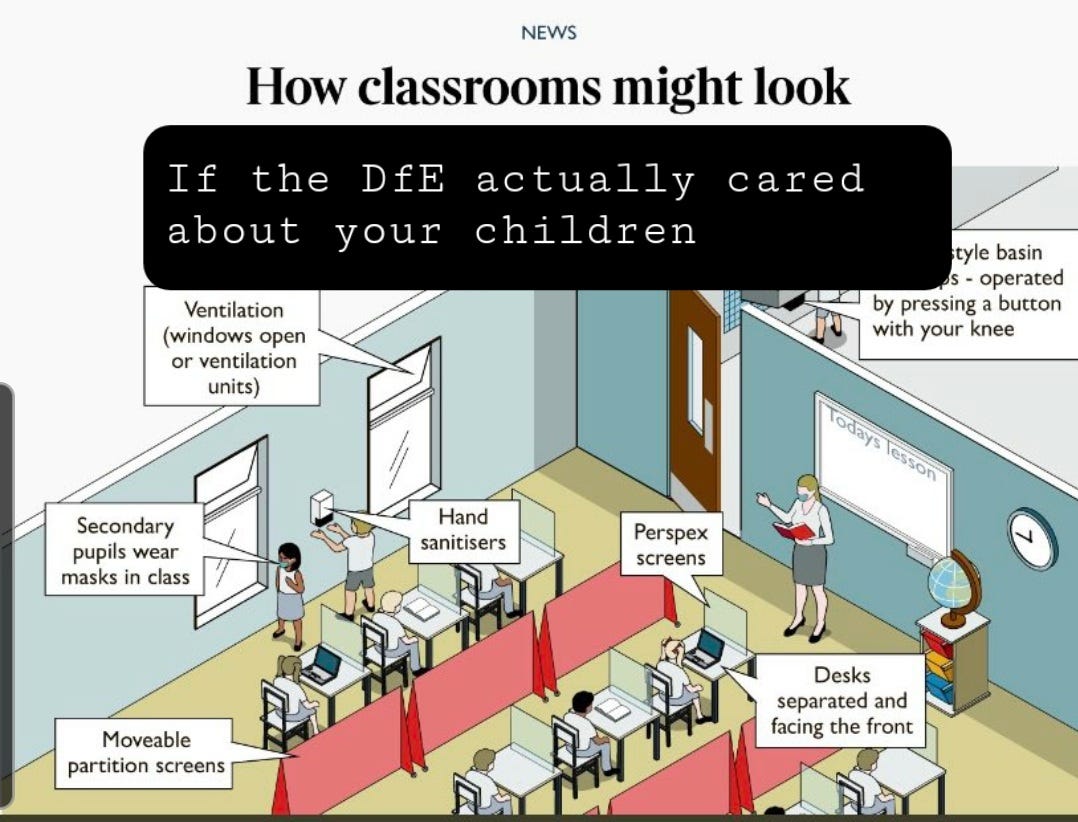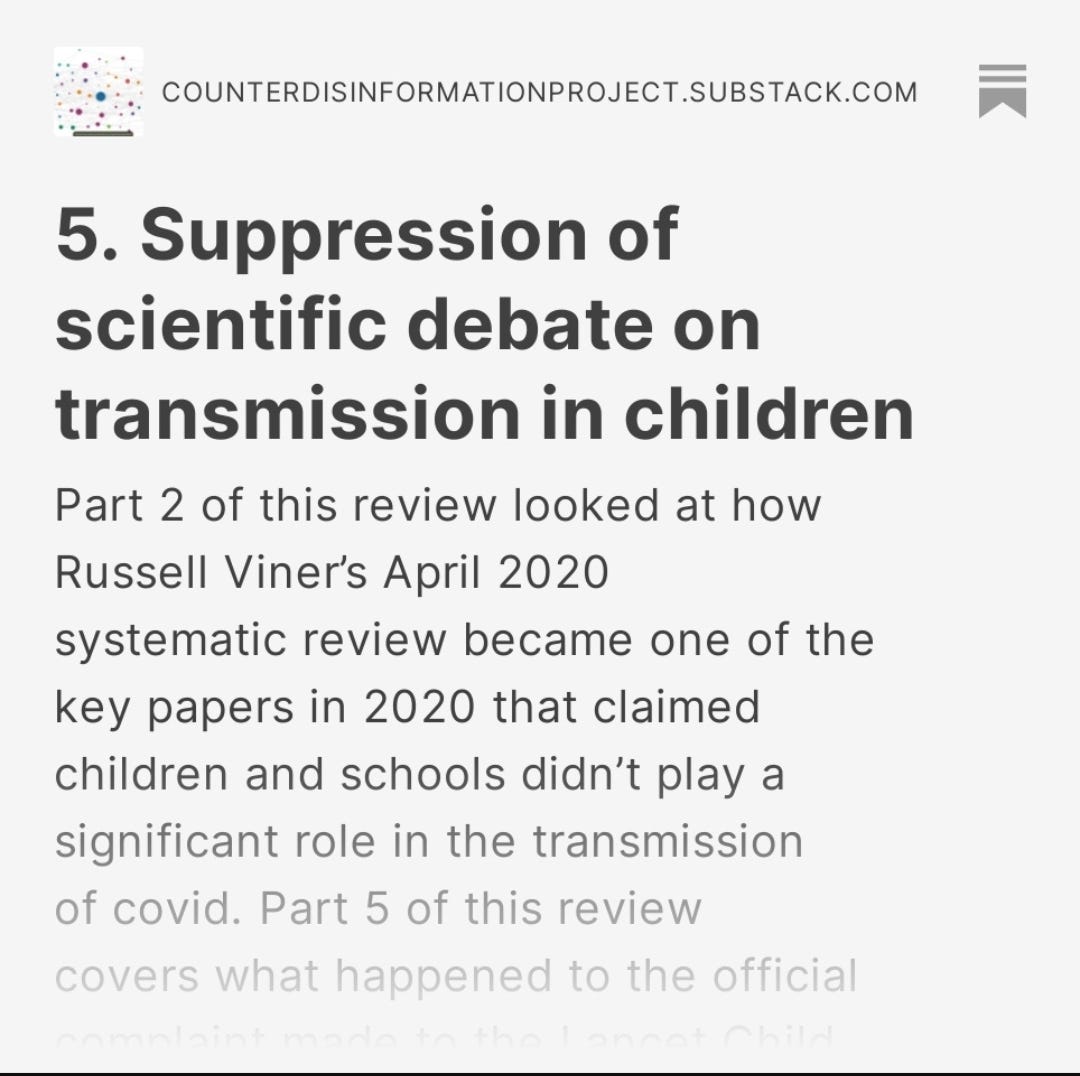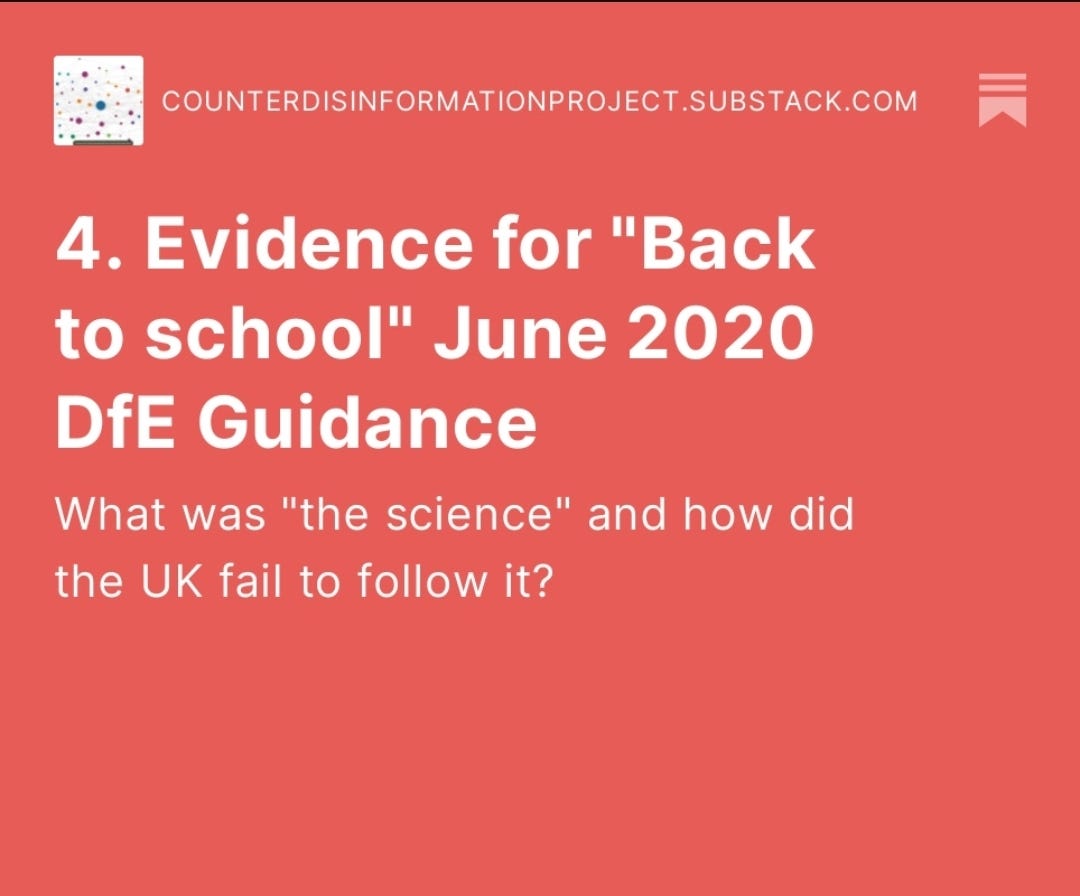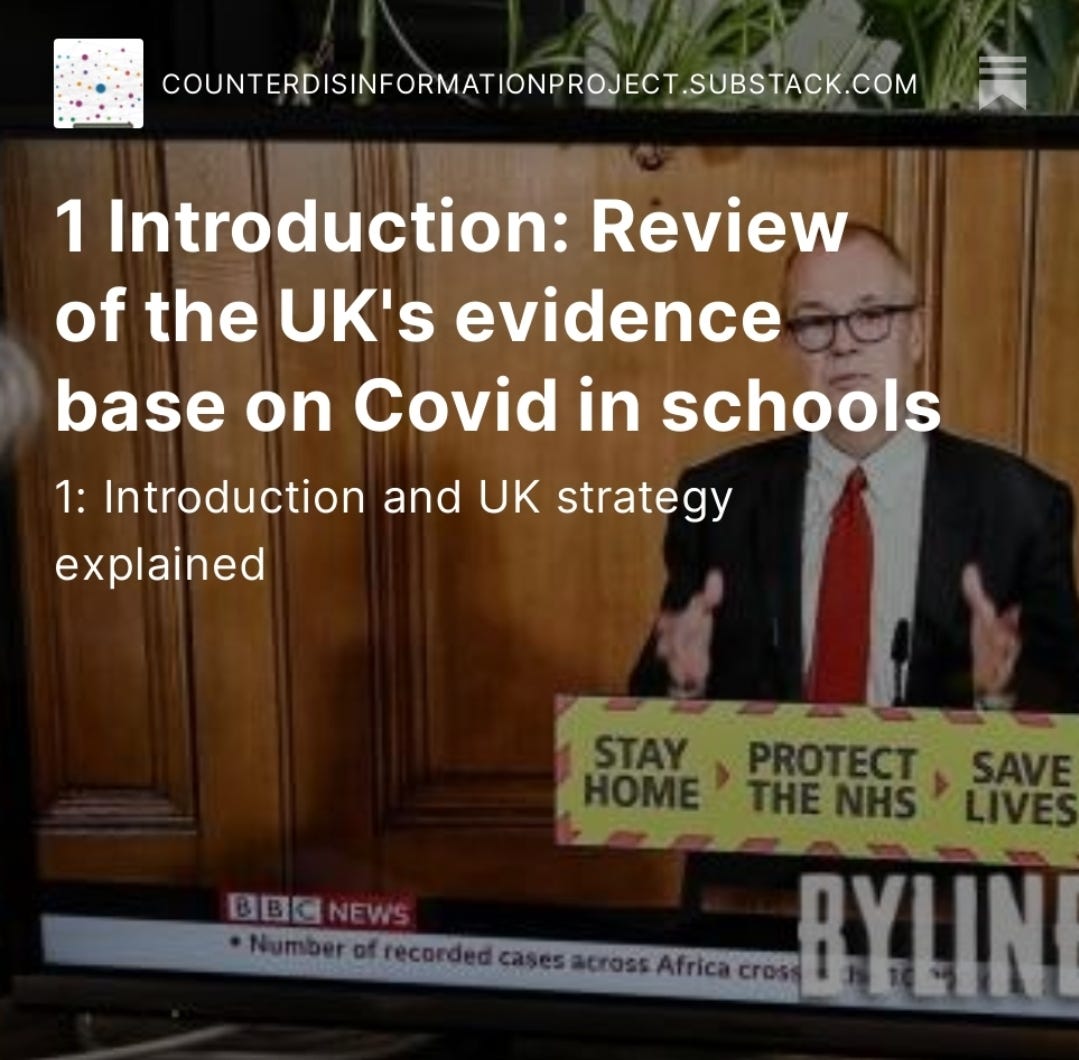13. Data on school transmission ignored, while outbreaks were censored - Nov/Dec 2020
What the media choose not to report can be more important than what they report,
Part 13 of this review examines how the scale of outbreaks in schools and evidence of transmission was ignored.
Late Circuit Breaker
At the start of November 2020 Boris Johnson introduced the circuit breaker lockdown a month after SAGE had recommended the measure.
From the government website
From Thursday 5 November, everyone must stay at home, and may leave only for a limited set of reasons. These include:
For education;
For work, if you cannot work from home;
For exercise and recreation outdoors, with your household, support bubble or on your own with one person from another household;
For all medical reasons, appointments and to escape injury or harm;
To shop for food and essentials;
And to provide care for vulnerable people, or as a volunteer.
Non-essential shops, leisure and entertainment venues will be closed. Click and collect services can continue and essential shops, including supermarkets, will remain open, so there is no need for anyone to stockpile.
Pubs, bars, restaurants must close, except for takeaway and delivery services.
People should work from home wherever possible. Workplaces should stay open where people cannot work from home – for example, in the construction or manufacturing sectors.
Shielding as practised in the spring will not currently be reintroduced. The clinically vulnerable, or those over the age of 60, should be especially careful to follow the rules and minimise contacts with others. Those who are clinically extremely vulnerable should not only minimise their contacts with others, but also not go to work if they are unable to work from home.
Focused protection without the protection
The lockdown was much looser than lockdowns and circuit breakers being implemented in many other countries. Hospitality, non-essential shopping and various entertainment businesses were closed, and socialising was also restricted, but otherwise workplaces could stay open. No additional measures were implemented in schools. Whether people could work from home or not became the decision of employers which was particularly problematic for workers in higher risk groups.
The failure to provide those who had been shielding the choice to return to shielding during a lockdown was an act of negligence. They were advised to be especially careful and to minimise contact with others, but if they had to go to work then they had no control over their working environment. The guidance provided no protection for these individuals, once again it seemed like the scale of people of working age or school age with health conditions was either not understood or ignored. In some schools education unions had to work hard to allow CEV members to have the right to wear a mask in the classroom yet in some cases they were still expected to attend assemblies with hundreds of students in unventilated halls.
If this was a focused protection strategy then the government failed to focus on protecting the vulnerable workers. The advocates of focused protection who celebrated the decision for schools to stay open without the introduction of adequate infection control measures did not speak up for those CEV workers who were left to the whims of their employers.
11. ONS ad hoc teachers study, Nov 2020
Published at the start of November 2020, the ONS ad hoc teachers study was an analysis of a snapshot of data taken from 2 September to 16 October. The paper was provided by government to justify its decisions on schools. On 3 Nov, the Department for Education tweeted a video of Chris Whitty saying:
Government Propaganda
Whilst schools struggled on with considerable disruption due to staff and student absences leading to many partial and temporary closures on 13 November the DfE released what can only be described as a propaganda video.
“Students being in school is vital. Not only for their education & learning, but also for their wellbeing.” A headteacher says while secondary school students line up in an empty corridor before being taught in a room with many students sitting on separate desks whilst wearing masks. The aim of the video was to demonstrate to the public that schools were safe and had put a considerable number of measures into place, referring to hand washing, staggered lunches, entrance and exit routines, however there is no mention of ventilation, the only windows in the video are shut.
The video was a lie, the DfE actively intervened to prevent schools from introducing mask wearing in classrooms, what’s interesting is that the DfE seemed to only intervene in schools that were named in articles in papers such as in the Telegraph which came with the obligatory comments from Us For Them. The reports appear to have come from Us For Them supporters, which demonstrates how small their grassroots base was in reality as a number of schools I know introduced masks without receiving media attention and without getting a call from the DfE. My own school being one such example.
So the DfE was preventing masks in classrooms while releasing videos of students wearing masks in classrooms, who was the target audience? It can’t have been those working in schools or the parents of students, both would have known the rules in their school wouldn’t have matched the video. The only people the video would have reassured were those with no direct knowledge of what was going on in schools.
Media censored outbreaks in schools
During November there were a number of headlines highlighting the locations which were seeing the highest number of outbreaks during the lockdown, the focus was primarily on supermarkets which in the third week of November accounted for around 18% of confirmed outbreaks however education had been split into different sectors, when added up education accounted for 28.4% of outbreaks. Sections of the media sought to pit education workers against supermarket staff, using the statistics to ask why education workers were calling for extra measures while expecting supermarket workers to continue facing a higher risk. They also ignored the fact supermarkets required masks at the time.
On the BBC’s Newsnight programme when they examined the main sources of outbreaks their bar chart missed off education leading to around 40% of covid exposures unaccounted for.
While the official statistics for outbreaks in schools were high, due to changes in testing and contact tracing many outbreaks were not included in the official statistics, as explained in a previous part of this review.
8. Autumn 2020: How contact testing in UK schools collapsed
This is a previous article reprinted as part of the Review of the UK's evidence base on Covid in schools. Recent attempts at revisionism are suggesting schools could have continued operating normally throughout lockdowns without disruption, this stance fails to acknowledge that schools faced continuous disruption for two years. Education is still struggl…
Data Ignored
On 12 November the ONS released its REACT-1 study which measured infection rates through large scale randomised sampling. There had been a clear reduction in swab positivity at the end of October (during half term)- driven by a drop in positivity in 5-12 yr olds. This was prior to lockdown, and seemed to be an England-wide trend. This added to the evidence being ignored by the government and most of the media that schools were driving transmission.
On 15 November the government’s Children’s Task and Finish group released its latest report for SAGE.
CTF stated that infections had increased since schools opened, particularly in those of school age, however its says the link is difficult to prove or disprove, later explains this is due to what data they have to use. Children were considered at low risk of severe symptoms, and quoting the ad hoc teachers’ risk study the CTF claimed education workers were at similar risk to other keyworkers.
The CTF noted there had been more than a 1000 outbreaks in schools, when the true number was multiple thousands. With low confidence the CTF said there was “no direct evidence transmission in schools significantly increases infections in children”, which is a recurring theme in the documents SAGE put out on transmission in children, not enough evidence, data, with low confidence.
However looking specifically at 12-16 year olds the CTF had more confidence that since schools opened in September students played a significant role in household transmission.
These less reassuring conclusions come from a different paper produced by the ONS also published around the same time as the ad hoc study on teachers’ risk. This paper concluded that children aged 2-16 were as infectious or very similar to adults. It found that when schools were closed children were as likely as adults to be the index case introducing covid into the household. After schools returned the likelihood of children aged 12-16 being the index case increased dramatically, the paper caveats this by saying it doesn’t necessarily mean that the infected children were infected in schools, however it's still a clear indicator that the possibility that schools were driving transmission should have been taken more seriously.
These findings didn’t make it into mainstream media, however it was shared widely online, and didn’t come as a surprise to educators and parents. The paediatricians working with the government dismissed the paper, citing other papers, many of which they had authored. The standard response to high infection rates in children at the time was to claim that the vast majority of child infections were occurring outside of school, sleepovers and playdates were suggested as the causes of infection, however data wasn’t provided as evidence to back up this assertion.
The UK relied almost entirely on its own studies, nearly all of which were produced by the same small group of people, international studies were mainly ignored except for a select few such as the work of Ludvigsson in Sweden which became controversial after internal emails were made public of exchanges between Ludvigsoon and Tegnell revealed that after identifying harm in children they discussed how to conceal such information from the Swedish public.
There were papers that didn’t show much evidence of transmission in schools, however the most widely quoted examples used data taken from the end of the summer term when schools were only partially open and infection rates were lower than they have been at any time since. Such papers had little relevance to the situation in November 2020 but they continued to be quoted, some were still being quoted in 2023. UKHSA, government and RCPCH refused to consider the possibility schools were driving transmission.
12. Schools Infection Survey
After the ad hoc study on teachers risk had been misrepresented in the media, wrongly describing a lack of evidence as no evidence of transmission; limitations that the UK Statistics Authority and the ONS recognised, the next important study conducted on behalf of the government was the first round of the Schools Infection Survey which was published on …
11. ONS ad hoc teachers study, Nov 2020
COUNTER DISINFORMATION PROJECT
·
28 AUG
10. How did the WHO's TAGs on covid in children respond to the Alpha wave?
COUNTER DISINFORMATION PROJECT
·
24 JUN
9. June - Oct 2020: UK influence on WHO Schools groups
COUNTER DISINFORMATION PROJECT
·
28 MAY
8. Autumn 2020: How contact testing in UK schools collapsed
COUNTER DISINFORMATION PROJECT
·
21 MAY
7. Why did the UK ignore calls for a September circuit breaker?
13 May
6. Who wrote the September 2020 schools guidance?
COUNTER DISINFORMATION PROJECT
·
26 APR
5. Suppression of scientific debate on transmission in children
COUNTER DISINFORMATION PROJECT
·
16 APR
4. Evidence for "Back to school" June 2020 DfE Guidance
COUNTER DISINFORMATION PROJECT
·
13 APR
3. UK Influence: Viner, Farrar, Fauci emails & ESPID
COUNTER DISINFORMATION PROJECT
·
9 APR
2. March - April 2020 "No child is known to have passed on Covid-19 to an adult"
COUNTER DISINFORMATION PROJECT
·
3 APR
1.Introduction: Review of the UK's evidence base on Covid in schools
COUNTER DISINFORMATION PROJECT
·
30 MAR






















